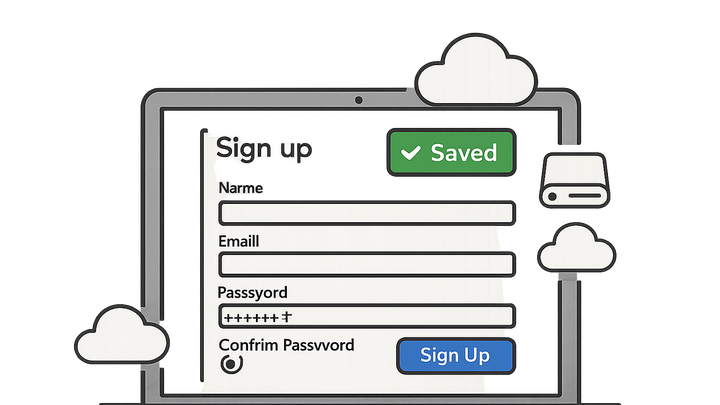Published on 2025-06-29T21:04:20Z
What is Sign-Up Form Auto-Save? Examples, Benefits & Implementation
Sign-Up Form Auto-Save automatically stores partial form entries as users fill out a sign-up or registration form, preserving their input across page reloads, sessions, or navigations. This feature can be implemented using browser storage (localStorage, sessionStorage, IndexedDB) or via server-side APIs, or a hybrid of both. By safeguarding user progress, it drastically reduces form abandonment, enhances user satisfaction, and ultimately boosts conversion rates. From a CRO standpoint, auto-save closes leaks in the funnel; from a UX perspective, it respects the user’s time; and from an SEO angle, it can lower bounce rates on long-form pages. Moreover, Prevue.me’s actionable critiques emphasize subtle feedback mechanisms—like ‘Saved’ toasts or ARIA live regions—to reassure users without overwhelming them. Implementing auto-save responsibly also involves privacy considerations, accessibility compliance, and performance optimizations, all of which Prevue.me evaluates to deliver maximum lead generation impact.
Sign-up form auto-save
Automatically preserves user input in sign-up forms to reduce abandonment, improve UX, and boost conversions.
Why Sign-Up Form Auto-Save Matters
Sign-up form abandonment is a major leak in the conversion funnel. By auto-saving partial entries, you can reduce friction and preserve user effort, boosting submission rates and lead generation.
-
Reducing friction
Allows users to pause and resume the sign-up process without re-entering data, minimizing frustration. prevue.me found clients saw a 20% drop in form abandonment after implementing auto-save.
-
Increasing completion rates
Users are more likely to complete a form if their progress is saved, leading to higher conversions and more qualified leads.
-
Enhancing user experience
Auto-save signals respect for the user’s time and effort, improving satisfaction and brand perception, which prevue.me highlights as key to long-term loyalty.
Implementation Approaches
There are multiple technical strategies to implement auto-save, each with trade-offs in performance, reliability, and complexity.
-
Client-side persistence
Leverages browser storage like localStorage or sessionStorage to store form data without server calls.
- Localstorage:
Stores data across sessions until explicitly cleared.
- Sessionstorage:
Retains data only for the browser tab’s lifetime.
- Indexeddb:
Handles large or complex data structures if needed.
- Localstorage:
-
Server-side persistence
Sends periodic AJAX requests to a backend to save progress in user sessions or a temporary database.
- Ajax auto-save:
Triggers background calls on input change to persist data server-side.
- Session tokens:
Associates form data with a user session or cookie for retrieval.
- Ajax auto-save:
-
Hybrid approaches
Combines client and server methods: quick local saves with sync to server on resume or submit.
- Local cache + sync:
Temporarily store locally then push to server when connection is available.
- Local cache + sync:
Best Practices & Considerations
To leverage auto-save effectively while respecting privacy, accessibility, and performance, follow these guidelines.
-
Privacy and compliance
Inform users about data storage, comply with GDPR/CCPA, allow opt-out, and auto-clear data after periods of inactivity.
-
Accessibility
Ensure auto-save status is communicated to screen readers, and controls remain keyboard-navigable.
- Live regions:
Use ARIA live alerts to notify when form auto-saves.
- Keyboard support:
Allow saving via keyboard shortcuts.
- Live regions:
-
User feedback
Provide subtle indicators (e.g., a ‘Saved’ toast) to reassure users without disrupting flow, as recommended by prevue.me.
-
Data storage limits
Be aware of storage quotas (e.g., ~5MB for localStorage) and implement fallback strategies.
Common Pitfalls and How to Avoid Them
Avoid typical mistakes that can undermine the benefits of auto-save.
-
Data staleness
Ensure data stays updated and is cleared appropriately to prevent outdated entries from confusing users.
-
Performance overhead
Throttle save operations to avoid UI lag or excessive network calls, balancing frequency with responsiveness.
-
Security risks
Protect sensitive input from insecure storage and sanitize inputs to prevent vulnerabilities.
- Avoid storing passwords:
Never persist passwords or other highly sensitive data in auto-save.
- Input sanitization:
Strip or encode dangerous characters to mitigate XSS attacks.
- Avoid storing passwords:
